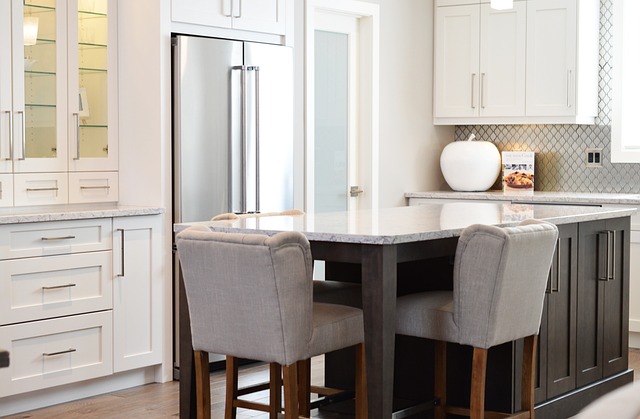First things first, grab a tape measure and a notepad. Start by measuring the width of your walls where the cabinets will go. Don’t just measure once; go for a couple of measurements at different heights. Walls can be a bit like that friend who always seems taller in photos—sometimes they’re not as straight as they appear!
Next, measure the height from the floor to the ceiling. If you’re planning to go all the way up, make sure to note any obstacles like windows or vents. Think of it like navigating a maze; you want to avoid any surprises that could throw off your plans.
Now, let’s talk about depth. Standard cabinets are usually about 24 inches deep, but if you’re dreaming of something custom, measure how deep you want them to be. Picture it like choosing the right size of a suitcase for your trip; too big, and it’s a hassle; too small, and you’re left with packing regrets.

Lastly, don’t forget to measure the space between the countertop and the upper cabinets. This area is crucial for functionality. You wouldn’t want to bump your head every time you reach for a spice jar, right?
So, take your time, jot down those numbers, and soon you’ll be on your way to creating the kitchen of your dreams!
The Ultimate Guide: Mastering the Art of Measuring for New Kitchen Cabinets
First off, grab a trusty tape measure. This little tool is your best friend in the world of kitchen renovations. Start by measuring the width, height, and depth of your existing cabinets, if you have them. But don’t stop there! You’ll also want to measure the space where the new cabinets will go. Think of it like fitting a puzzle piece; you need to know the dimensions to ensure everything clicks together perfectly.
Next, consider the layout. Are you going for a U-shape, L-shape, or maybe a galley kitchen? Each layout has its quirks, and understanding these will help you visualize how your new cabinets will fit into the overall design. Picture it like a game of Tetris—each piece needs to fit snugly without leaving awkward gaps.
Don’t forget about the height! Standard cabinet heights are usually around 30 inches, but if you’re tall or short, you might want to adjust that. Imagine reaching for a dish on a high shelf; it can be a real workout if those cabinets are too high!
Avoid Costly Mistakes: Essential Tips for Accurate Kitchen Cabinet Measurements
First off, grab a trusty tape measure. It’s your best friend in this journey. Start by measuring the height, width, and depth of the area where your cabinets will go. But don’t just stop there! Check for any irregularities in the walls or floors. You wouldn’t want to install cabinets only to discover they’re leaning like the Tower of Pisa, right?
Next, consider the layout. Are you going for a U-shape, L-shape, or something more unique? Sketch it out! Visualizing your space can help you see where those cabinets will fit best. And don’t forget about the appliances! Make sure to measure around your fridge, stove, and dishwasher. You want to ensure there’s enough room for them to breathe and function properly.

Now, let’s talk about the height of your cabinets. If you’re tall, you might want them higher, but if you’re on the shorter side, lower cabinets could save you from a daily game of “how high can I reach?” Also, think about the space between the countertop and the upper cabinets. Too little space can make your kitchen feel cramped, while too much can look awkward.
Lastly, always double-check your measurements. It’s like proofreading an important email—one small mistake can lead to big headaches. So, take your time, measure twice, and breathe easy knowing you’re on the right track to a stunning kitchen transformation!
Transform Your Space: Step-by-Step Instructions for Measuring Kitchen Cabinets Like a Pro
First things first, grab a trusty tape measure. This little tool is your best friend in this adventure. Start by measuring the width of your cabinets. Place one end of the tape at the left edge and stretch it all the way to the right. Easy peasy, right? Don’t forget to jot down those numbers; they’re your golden tickets to a perfectly fitted kitchen.
Next up, let’s tackle the height. Measure from the floor to the top of the cabinet. If you’ve got upper cabinets, measure from the bottom of those to the ceiling. Think of it like measuring a tree; you want to know how tall it stands!
Now, let’s not skip the depth. This is crucial, especially if you’re planning to add new appliances or decor. Measure from the front edge of the cabinet to the back wall. It’s like checking how deep a pool is before diving in—safety first!
And here’s a pro tip: always measure in three places—left, center, and right. Why? Because walls can be a bit wonky, and you want to ensure your cabinets fit snugly.
Finally, take a moment to visualize your dream kitchen. With these measurements in hand, you’re one step closer to transforming your space into a culinary haven. So, are you ready to unleash your inner designer? Let’s get measuring!
From Blueprint to Reality: How to Measure Your Kitchen for Perfect Cabinet Fit
Start by measuring the width of your walls. It’s like taking the pulse of your kitchen; you need to know how much space you’re working with. Don’t forget to measure from corner to corner, and jot down those numbers. Next, dive into the height. Measure from the floor to the ceiling, and if you have any obstacles like windows or vents, make sure to note their heights too. Think of it as mapping out a treasure hunt; every detail counts!
Now, let’s talk about depth. Standard cabinets are usually 24 inches deep, but if you’re dreaming of something custom, you’ll want to measure how far you can go without blocking pathways or making your kitchen feel cramped. Picture it like fitting a new sofa into your living room; you want it to fit just right without overwhelming the space.
And here’s a pro tip: always measure in three places—top, middle, and bottom. Walls can be a bit like people; they’re not always perfectly straight! This way, you’ll ensure your cabinets sit snugly, avoiding any awkward gaps that could ruin your kitchen’s vibe.
Unlock Your Kitchen’s Potential: Expert Advice on Measuring for New Cabinets
First things first, grab a tape measure. This trusty tool is your best friend in the quest for the perfect fit. Start by measuring the width, height, and depth of your existing cabinets, if you have them. But don’t stop there! Measure the space where your new cabinets will go. Think of it like fitting a puzzle piece; you want to ensure everything aligns seamlessly.
Now, here’s a pro tip: always measure in multiple spots. Walls can be a bit like that friend who can’t make up their mind—sometimes they’re straight, and other times they’re not! So, measure at the top, middle, and bottom of the space to get a true sense of the dimensions.
Next, consider the layout. Are you dreaming of a U-shaped kitchen or a galley style? Visualize how you want to move around the space. It’s like choreographing a dance; you want to ensure there’s enough room to twirl without bumping into the fridge!
And let’s not forget about the height! If you’re tall, you might want cabinets that reach the ceiling. If you’re on the shorter side, lower cabinets might be your best bet. Think about accessibility—after all, you want to enjoy your kitchen, not feel like you’re on a treasure hunt every time you need a pot.
Frequently Asked Questions
What Dimensions Should I Consider When Measuring?
When measuring, consider the length, width, height, and depth of the object. Additionally, account for any irregular shapes or features that may affect the overall dimensions. Ensure to use appropriate units of measurement and tools for accuracy.
What Common Mistakes Should I Avoid When Measuring?
When measuring, avoid common errors such as not using the right tools, misreading measurements, failing to account for temperature variations, and neglecting to measure from the correct reference point. Ensure accuracy by double-checking your measurements and using consistent techniques.
What Tools Do I Need to Measure for Cabinets?
To accurately measure for cabinets, you will need a tape measure, a level, a pencil, and a notepad. The tape measure helps you determine the dimensions of the space and the cabinets, while the level ensures that your cabinets will be installed straight. Use the pencil to mark measurements, and the notepad to keep track of your dimensions and notes.
How Do I Measure My Kitchen for New Cabinets?
To measure your kitchen for new cabinets, start by clearing the area and gathering tools like a tape measure and a notepad. Measure the width and height of each wall where cabinets will be installed, noting any windows, doors, or obstacles. Record the measurements in inches, and consider the depth of the cabinets you want. Ensure to measure from the floor to the ceiling for tall cabinets and account for any appliances. Accurate measurements will help you choose the right cabinet sizes and ensure a proper fit.
How Do I Measure for Cabinet Height and Depth?
To measure cabinet height, use a tape measure from the floor to the desired top of the cabinet. For depth, measure from the front edge to the back wall. Ensure to account for any trim or molding that may affect the measurements.
